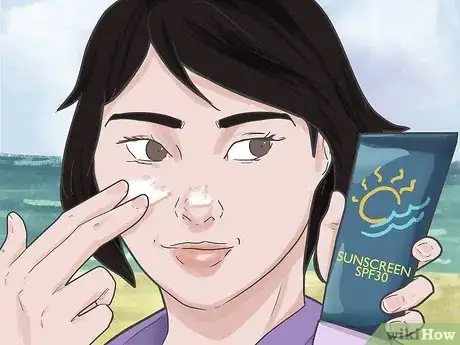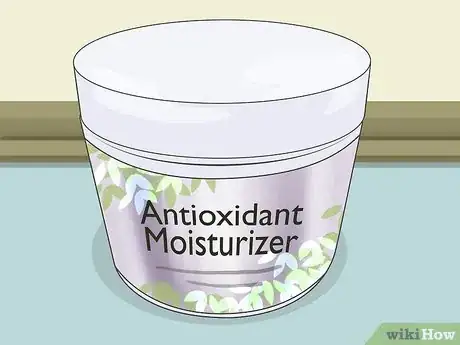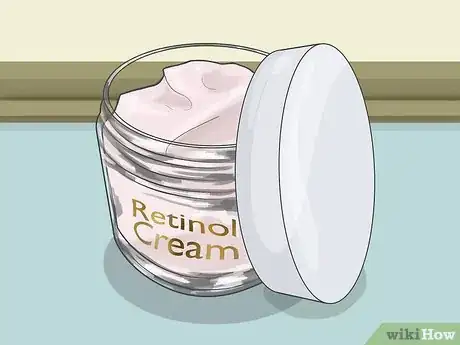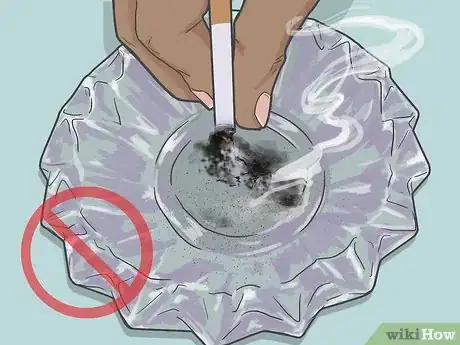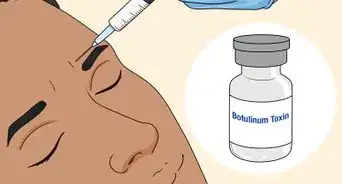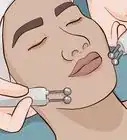This article was co-authored by Adarsh Vijay Mudgil, MD. Dr. Adarsh Vijay Mudgil is a board certified Dermatologist, Dermatopathologist, and the Owner of Mudgil Dermatology, a state-of-the-art dermatology practice based in New York, New York. As one of the few dermatologists in the area to achieve board certification in both dermatology and dermatopathology, Dr. Mudgil specializes in all aspects of medical, surgical, and cosmetic dermatology. He received his Bachelor's degree with Phi Beta Kappa honors from Emory University and earned his Doctor of Medicine (MD) with Alpha Omega Alpha honors from the Stony Brook University School of Medicine. In medical school, Dr. Mudgil was among a handful of students nationwide to receive a coveted Howard Hughes Medical Institute Fellowship and Scholarship. He then completed his residency in dermatology at the Mount Sinai Medical Center in Manhattan, where he served as chief resident. Additionally, Dr. Mudgil went on to complete a fellowship at the prestigious Ackerman Academy of Dermatopathology. He is a fellow of the American Academy of Dermatology, the American Society for Dermatologic Surgery, and the American Society of Dermatopathology. Dr. Mudgil is also a member of the Mount Sinai School of Medicine teaching faculty.
There are 14 references cited in this article, which can be found at the bottom of the page.
This article has been viewed 12,948 times.
While sagging skin is often a natural part of aging, it can still seriously impact your self-esteem, especially when it happens prematurely. Thankfully, there are several things you can do to help prevent your facial skin from sagging prematurely. By using topical treatments and maintaining healthy habits, you’ll be able to keep your facial skin tight and reduce any natural skin sagging that may occur in the future.
Steps
Using Preventative Topical Treatments
-
1Wear SPF 30 sunscreen to protect your face from damaging UV rays.[1] Overexposure to the sun’s harmful UV rays can degrade your skin’s collagen and elastin more quickly than it would naturally. By wearing sunscreen everyday, you can reduce the sun’s effects on your skin and help prevent your face from sagging.[2]
- Look for sunscreens that contain zinc oxide, which physically block the sun’s rays by reflecting light away from your skin, and have at least an SPF 30.[3]
- While UVB rays are much stronger in the summer, UVA rays cause damage to your skin as well. Therefore, it’s important that you use sun protection all year round.
- In addition to wearing sunscreen, wearing a wide-brimmed hat can help protect your face from the sun.
-
2Apply an antioxidant moisturizer daily to keep your skin hydrated. One of the primary causes of sagging skin is dehydration, which makes your skin more susceptible to environmental damage. Moisturizers with antioxidants, such as vitamins A, C, E, and CoQ10, help your skin stay plump and lifted while protecting it from the sun and pollution.[4]
- In addition, moisturizers with cholesterol, ceramides, and essential fatty acids can help maintain your skin’s natural barrier against harmful environmental factors.
- Most moisturizers can be applied once in the morning and again in the evening. However, check the label on the bottle to ensure that you use your moisturizer as instructed.
Advertisement -
3Use a retinol cream at night to help boost collagen production. Using a retinol cream is one of the only proven ways to help boost the production of collagen, a protein that helps keep your skin supple and youthful.[5] While retinol is effective at both preventing sagging and tightening already loosening skin, it can be irritating for many skin types.[6]
- Because retinol is harsh on your skin, it can be helpful to start slow and only apply your retinol cream twice per week until your skin acclimates. Once you can apply the cream without any irritation, you can increase your usage until you’re able to use it once per day.[7]
- Exposure to UV rays may make your retinol cream less effective and could make your skin more sensitive to the sun, so you may want to only apply your retinol cream at night.[8]
-
4Wash your face twice per day to remove irritating environmental factors. Most people are exposed to factors that can irritate facial skin every day, such as sweating, makeup, wearing a hat, and pollution.[9] While the level of irritation varies depending on your lifestyle and skin type, these common irritants can accelerate your skin’s aging process. Washing your face twice per day will help prevent premature sagging by calming your skin and removing any potentially irritating substances.[10]
- In addition to washing twice per day, washing your face after a sweaty workout will help calm your skin and allow it to repair itself more quickly.
Maintaining Healthy Habits
-
1Exercise to maintain a healthy weight and improve your circulation.[11] Holding onto extra weight can both stretch your facial skin and weaken the elastin in your face, which can cause or worsen facial sagging. Exercising regularly will help you maintain a healthy weight and improve your circulation, which can help slow the aging process.[12]
- While the recommended amount of exercise varies from one person to another, in general, aim to get at least 150 minutes of aerobic activity in per week.[13]
-
2Eat foods rich in antioxidants to fight harmful environmental factors.[14] Like using a moisturizer with antioxidants, consuming foods that are rich in antioxidants will help prevent sagging facial skin by protecting your skin and improving its ability to repair itself.[15] In particular, focus on foods that contain carotenoids, lycopene, zinc, essential fatty acids, and vitamins C and E.[16]
- For example, yellow and orange peppers, tomatoes, avocados, broccoli, and salmon are all high in antioxidants that keep your skin plump and help protect it from sun and pollution exposure.
- In addition, drinking green tea may help prevent your skin from sagging.[17]
-
3Steer clear of too many sweets and processed foods. While indulging in your favorite desserts and snacks is fine occasionally, overindulging may speed up aging and make your facial skin start to sag faster.[18] To maintain your skin’s collagen and elastin, try to limit your intake of sugar and processed foods, such as potato chips, to special occasions or the occasional treat.
- When you eat too much sugar, for example, your body forms molecules called advanced glycation end products, which can weaken collagen and elastin in your face.
-
4Limit your intake of alcohol to avoid dehydration. While alcohol is generally fine in moderation, overconsumption dehydrates your skin, which can cause it to age and sag prematurely.[19] By limiting your alcohol intake, you can help prevent facial sagging and allow your skin to stay hydrate and supple.
- While it’s important to talk to your doctor to determine the amount of alcohol you can safely consume, most people can generally consume 1 to 2 alcoholic drinks per day and remain healthy.[20]
-
5Avoid smoking to keep your skin from aging prematurely. Smoking can drastically speed up the break down of collagen in your facial skin, which can both cause sagging and worsen already sagging skin.[21] Because it causes extensive damage to your skin, smoking can also lead to an influx of age spots and wrinkles.[22] Therefore, if you want to prevent sagging and other signs of aging, it’s best to avoid smoking to keep your skin healthier.
- If you currently smoke, using a tobacco aid, seeking outside support, or deciding to go cold turkey can help you quit smoking and keep the skin on your face from sagging prematurely.
-
6Find healthy ways to manage your stress as much as possible. Finding ways to manage and, where possible, reduce the stress in your life can help prevent signs of premature aging, including sagging. While some stress can be healthy and motivating, too much stress can impact your body’s ability to repair itself on a cellular level and hinder your body’s ability to rejuvenate your facial skin.[23]
- While everyone relieves stress differently, it can be helpful to try out some relaxing activities, such as taking a bath, drinking a cup of tea, or getting a massage.
- Exercising can be a great way to both relieve stress and maintain a healthy weight, both of which will help you prevent saggy facial skin.
References
- ↑ Adarsh Vijay Mudgil, MD. Board Certified Dermatologist & Dermatopathologist. Expert Interview. 8 October 2020.
- ↑ https://www.health.harvard.edu/staying-healthy/why-your-face-ages-and-what-you-can-do
- ↑ https://www.aad.org/sun-protection/sunscreen-faqs
- ↑ https://www.nytimes.com/2016/06/30/fashion/skin-beauty-health-tips-pollution.html?
- ↑ Adarsh Vijay Mudgil, MD. Board Certified Dermatologist & Dermatopathologist. Expert Interview. 8 October 2020.
- ↑ https://www.aad.org/cosmetic/younger-looking/firm-sagging-skin
- ↑ https://www.health.harvard.edu/staying-healthy/do-retinoids-really-reduce-wrinkles
- ↑ https://www.nytimes.com/2019/03/14/style/retinol-questions-answers.html
- ↑ Adarsh Vijay Mudgil, MD. Board Certified Dermatologist & Dermatopathologist. Expert Interview. 8 October 2020.
- ↑ https://www.aad.org/skin-care-secrets/reduce-premature-aging-skin
- ↑ Adarsh Vijay Mudgil, MD. Board Certified Dermatologist & Dermatopathologist. Expert Interview. 8 October 2020.
- ↑ https://www.aad.org/skin-care-secrets/reduce-premature-aging-skin
- ↑ https://www.mayoclinic.org/healthy-lifestyle/fitness/expert-answers/exercise/faq-20057916
- ↑ Adarsh Vijay Mudgil, MD. Board Certified Dermatologist & Dermatopathologist. Expert Interview. 8 October 2020.
- ↑ https://www.aad.org/cosmetic/younger-looking/firm-sagging-skin
- ↑ https://universityhealthnews.com/daily/nutrition/top-foods-that-prevent-wrinkles-and-improve-skin/
- ↑ https://www.pacificcollege.edu/news/blog/2014/08/03/green-tea-fight-against-aging
- ↑ https://www.forbes.com/sites/quora/2017/01/20/does-eating-sugar-really-cause-acne/#33f405895af4
- ↑ https://www.aad.org/skin-care-secrets/reduce-premature-aging-skin
- ↑ https://www.mayoclinic.org/healthy-lifestyle/nutrition-and-healthy-eating/in-depth/alcohol/art-20044551
- ↑ Adarsh Vijay Mudgil, MD. Board Certified Dermatologist & Dermatopathologist. Expert Interview. 8 October 2020.
- ↑ https://www.aad.org/cosmetic/younger-looking/firm-sagging-skin
- ↑ https://www.psychologytoday.com/us/blog/the-athletes-way/201404/emotional-distress-can-speed-cellular-aging
